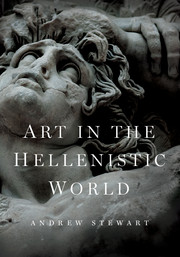Book contents
- Frontmatter
- Contents
- List of Illustrations
- Preface
- Introduction
- 1 Settlement
- 2 Power
- 3 Victory
- 4 Benefaction
- Focus I The Great Altar of Pergamon
- Focus II Hellenistic Mosaics
- 9 Luxury
- 10 Difference
- 11 Death
- 12 Reception
- Appendix A The Artist
- Appendix B Kallixeinos of Rhodes on the Wonders of Alexandria
- Glossary
- Timeline
- Biographical Sketches
- Select Bibliography and Further Reading
- References
- Sources of Illustrations
- Index
10 - Difference
Published online by Cambridge University Press: 05 October 2014
- Frontmatter
- Contents
- List of Illustrations
- Preface
- Introduction
- 1 Settlement
- 2 Power
- 3 Victory
- 4 Benefaction
- Focus I The Great Altar of Pergamon
- Focus II Hellenistic Mosaics
- 9 Luxury
- 10 Difference
- 11 Death
- 12 Reception
- Appendix A The Artist
- Appendix B Kallixeinos of Rhodes on the Wonders of Alexandria
- Glossary
- Timeline
- Biographical Sketches
- Select Bibliography and Further Reading
- References
- Sources of Illustrations
- Index
Summary
Two key representatives of the Hellenistic world’s Other – Persians and Celts – have appeared already in Chapter 3. There we saw that both texts and images, such as the Alexander Mosaic and Big and Little Barbarians (Figures 3, 37, 41–44), classify these barbarian assailants into two types: the sophisticated, bringers of tyranny, and the savage, bringers of chaos. Branching out, this chapter first examines the conquered and colonized, focusing on Egypt; then the Hellenistic underclass; and finally, the Roman intruders.
THE NILE MOSAIC AT PRAENESTE
The Nile Mosaic (Figures 136–38) is one of the largest ancient figured floor mosaics preserved – or it would be, if various misfortunes had not destroyed about half of it and severely damaged the rest. Laid around 125–100, it decorated the basilica of an enigmatic complex at the foot of the great hillside sanctuary of Fortuna at Praeneste (modern Palestrina), twenty-two miles east of Rome. Two obelisks found nearby, coupled with the presence of a Latin dedication to Isis-Fortuna (Tychē), suggest that the complex may have been dedicated to this composite Egypto-Roman goddess.
Although the mosaic is now a collage of nineteen separate segments, one of which has even found its way to Berlin (Figure 129), its overall layout is clear. At the top, expanses of sky frequented by ibises and herons canopy a rocky wilderness inhabited by wild animals and Africans. This is Ethiopia and Nubia, “land of the blacks.” Other segments show this wilderness above and civilized life below (Figure 137: see the rhinoceros at right and the small enclosed temple and tower houses below it, respectively). They must come from the middle zone of the composition. The rest show a seacoast, harbor, and the Mediterranean Sea (Figure 138 bottom right). Some features also bridge two or more segments, enabling their juxtaposition. Yet several key segments are still “floating,” so what follows will not depend on any particular reconstruction, of which there are several.
- Type
- Chapter
- Information
- Art in the Hellenistic WorldAn Introduction, pp. 227 - 244Publisher: Cambridge University PressPrint publication year: 2014



